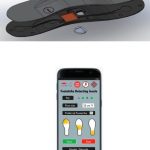 Earlier this year I wrote about an interesting startup called Sensoria, who develop sensors that can be embedded in all manner of normal items to render them ‘smart’, including running shoes. The sensors capture a number of key data streams relevant for runners, including cadence and gate.
Earlier this year I wrote about an interesting startup called Sensoria, who develop sensors that can be embedded in all manner of normal items to render them ‘smart’, including running shoes. The sensors capture a number of key data streams relevant for runners, including cadence and gate.
The data is sent to an accompanying app, which provides a range of analytics and coaching support to help the athlete as they workout. By decoupling the analysis component from the measurement component, it makes it easy for athletes to use multiple garments to perform the same task.
The focal point of the app is a smartcoach, known as Mara, which can provide athletes with a verbal commentary of their run. So, for instance, you might get updates of your mile times to monitor your pacing. Mara is capable of reporting on any metric captured, including the usual speed and distance, but also cadence, foot landing and heart rate zone.
The app is designed to work alongside whatever else is playing on your phone, so you can listen to your favorite music, and the volume will adjust itself whenever Mara needs to ‘talk’ to you.
What’s more, the device is even capable of recommending a change of footwear based upon your usage patterns, with the platform connected up with a range of manufacturers. The company claim that they can match the ideal footwear for your particular style based upon the data generated as you run.
Smarter running
A similar project has been undertaken by a team from The Hong Kong Polytechnic University (PolyU). They’ve developed a mobile biofeedback device that is capable of monitoring footstrike patterns in runners, with the aim being to reduce injuries and air rehabilitation.
It’s long been known that the way the runner’s foot strikes the ground has a big part to play in the likelihood of injury. Indeed, it’s now believed that heel or forefoot strike may present a greater chance of developing injuries such as Achilles tendinitis and stress fractures.
As such, midfoot striking is the optimal technique to reduce injuries, but it’s a technique that is difficult to develop. The invention aims to support this by providing real-time information about footstrike patterns as we run, with the data sent to a smartphone app.
It’s a nice example of how technology is continuing to evolve to help athletes of all types perform better and more effectively. Whilst it is not currently available on the market, it is nonetheless a strong sign of where things will go.